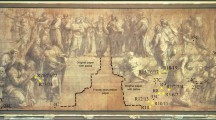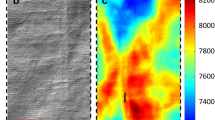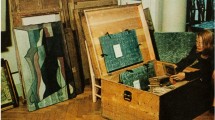Abstract
The Italian dialect poet Cesare Pascarella travelled all around the world, noting down in notebooks his keen and caustic observations, and drawing sketches that are a visual reportage of his journeys. The sketches were mounted as a random collage over acidic cardboards that were exposed to direct sunlight in his studio. Their poor state of conservation is related to the use of modern paper: chemical instability of raw materials caused acidification and strong oxidation of the support, with intense yellowing of the surfaces and brittleness of the paper. To ensure future preservation of the drawings, chemical stabilisation with simultaneous alcoholic treatment by deacidification (calcium propionate) and reduction (borane tert-butylamine complex) appeared necessary. To verify its applicability, it was indispensible to characterise the support and identify the nature of all the graphic media. The use of Raman, Infrared, X-ray fluorescence spectroscopies and scanning electron microscopy coupled with X-ray microanalysis allowed us to clear the problems related to the different penetration depth of each analytical technique and the different responses of pigments/dyes to each spectroscopy. The palette, how it varied along the journeys, the different supports used and preparations were completely identified showing a choice of colours compatible with the reduction treatment.

Top: Drawing A12. Left: before chemical stabilisation and conservation treatment. Right: after chemical deacidification/reduction and the final conservation intervention. Bottom Left: SEM image of the paper composition of drawing A19. Bottom right: Raman spectra of the paper support of drawing B6 before and after the reduction treatment. On the top, the spectra without baseline correction; on the bottom, the spectrum after reduction is compared with a standard spectrum of pure cellulose paper that shows a perfect recovery of the original structure of the paper after the chemical treatment.














Similar content being viewed by others
References
Bioletti S, Leahy R, Fields J, Meehan B, Blau W (2009) The examination of the Book of Kells using micro-Raman spectroscopy. J Raman Spectrosc 40:1043–1049
Bicchieri M, Monti M, Piantanida G, Sodo A (2008) All that is iron ink is not always iron-gall. J Raman Spectrosc 39:1074–1078
Bicchieri M, Sodo A, Piantanida G, Coluzza C (2006) Analysis of degraded papers by non-destructive spectroscopic techniques. J Raman Spectrosc 37:1186–1192
Mansoa M, Carvalho ML (2009) Application of spectroscopic techniques for the study of paper documents: A survey. Spectrochim Acta B 64:482–490
Workman JJ Jr (2001) Infrared and Raman spectroscopy in paper and pulp analysis. Appl Spectrosc Rev 36:139–168
Hochleitner B, Desnica V, Mantler M, Schreiner M (2003) Historical pigments: a collection analyzed with X-ray diffraction analysis and X-ray fluorescence analysis in order to create a database*1. Spectrochim Acta B 58:641–649
Ferrero JL, Roldán C, Navarro E, Ardid M, Marzal M, Almirante J, Ineba P, Vergara J, Mata C (1999) Applications of the X-ray fluorescence analysis to the cultural patrimony of the Comunidad Valenciana (Spain): Painting, metal and paper. J Radioanal Nucl Ch 240:523–528
Roux S, Feugeas F, Bach M, Fagon M, Bettinger C, Mourad S, Cornet A (2008) Determination of paper filler Z-distribution by low-vacuum SEM and EDX. J Microsc 229:44–59
Goldstein J, Newbury D, Joy D, Lyman C, Echlin P, Lifshin E, Sawyer L, Michael E (2003) Scanning Electron Microscopy and X-ray Microanalysis 3 rd edn. Kluver, New York
Richards GN (1971) In: Bikales NM, Segal L (eds) Cellulose and cellulose derivatives Part V, 2nd edn. New York, Wiley
Van Loon LR, Glaus MA (1997) Review of the kinetics of alkaline degradation of cellulose in view of its relevance for safety assessment of radioactive waste repositories. J Polym Environ 5(2):97–109
Walker ERH (1976) The functional group selectivity of complex hydride reducing agents. Chem Soc Rev 5(1):23–50
Block I, Kim HK (1986) In: Needles H, Zeronian SH (eds) Historic Textile and Paper Materials. Washington DC, ACS
Andrews GC (1980) Chemoselectivity in the reduction of aldehydes and ketones with amine boranes. Tetrahedron Lett 21:679–700
Raber DJ, Guida WC, Shoenberger DC (1981) Reduction of aldehydes and ketones with tetraalkylammonium borohydrides. Tetrahedron Lett 22:5107–5110
Tang LC (1986) In: Needles H, Zeronian SH (eds) Historic Textile and Paper Materials. Washington DC, ACS
Burgess HD (1990) The stabilization of cellulosic fibres by borohydride derivatives. ICOM Committe For Conservation 2:447–452
Bicchieri M, Brusa P (1997) The bleaching of paper by reduction with borane tert-butylamine complex. Restaurator 18(1):1–11
Bicchieri M, Bella M, Sementilli F (1999) A quantitative measure of borane tert–butylamine complex effectiveness in carbonyl reduction of aged papers. Restaurator 20(1):22–29
Bicchieri M, Curini R, D’Ascenzo G, Orrù MA (2000) Characterization of oxidized and reduced papers by thermogravimetric analysis—effectiveness of reducing treatments. Qvinio 2:93–101
Capitani D, Segre AL, Pentimalli M, Bicchieri M, Munafò PF (2000) Ancient deteriorated paper: washing and restoring processes as studied by 13 C CP-MAS NMR spectroscopy. Qvinio 2:37–43
Pedneault C, Robert S, Pellerin C (1997) Bleaching with new reductive chemicals: replacement of hydrosulfite. Pulp Pap Can 98(3):51–55
Bicchieri M, Sementilli FM, Sodo A (2000) Application of seven borane complexes in paper conservation. Restaurator 21(4):213–228
Sanna C, Sodo A, Laguzzi G, Mancini G, Bicchieri M (2009) Tert-butyl amine borane complex: an unusual application of a reducing agent on model molecules of cellulose based materials. J Cult Herit 10(3):356–361
Plossi Zappalà M (1994) Il propionato di calcio nella deacidificazione e stabilizzazione della carta. Cellulosa e Carta 45:53–60
Bicchieri M, Monti M, Antonelli ML (2001) In: J. Apuente (ed) Proceedings of the 3 rd International Conference on Science and Technology for the safeguard of cultural heritage in the mediterranean basin Vol. I. Universitad de Alcalà, Alcalà
Coluzza C, Bicchieri M, Monti M, Piantanida G, Sodo A (2008) Atomic force microscopy application for degradation diagnostics in library heritage. Surf Interface Anal 40(9):1248–1253
http://www.icpal.beniculturali.it/allegati/Capitolato_Speciale_Tecnico_Tipo.pdf
Pace G (1999) In: Fiorani F, Di Noia R (eds) De Nittis incisore. Roma, Artemide
Bicchieri M, Storace MS (2004) In: Lo stato dell’arte 2: Conservazione e restauro, confronto di esperienze. Atti del II Congresso Nazionale dell’IGIIC, Il Prato, Saonara
Iannuccelli S, Sotgiu S, Missori M (2004) In: Lo stato dell’arte 2: Conservazione e restauro, confronto di esperienze. Atti del II Congresso Nazionale dell’IGIIC, Il Prato, Saonara
Iannuccelli S, Storace MS (2005) The conservation of Matthaeus Greuter’s Ancient Map of Italy. Beitrage zur Erhaltung von Kunst und Kulturgut Heft 1:36–42
Sotgiu S, Iannuccelli S (2006) In: Carrarini R, Casetti Brach C (ed) Libri e Carte. Restauro e analisi diagnostiche, Gangemi, Roma
Sotgiu S, Iannuccelli S (2010) In: XXI Secolo-L’universo fisico. Istituto della Enciclopedia Italiana Treccani, Roma
Pinzari F, Zotti M, De Mico A, Calvini P (2010) Biodegradation of inorganic components in paper documents: formation of calcium oxalate crystals as a consequence of Aspergillus terreus Thom growth. Int Biodeter Biodegr 64:499–505
McNamara CJ, Konkol N, Mitchell R (2010) In: Mitchell R, Gu J-D (eds) Environmental Microbiology, 2nd edn. Wiley, Hoboken, NJ
Reich S, Thomsen C (2004) Raman spectroscopy of graphite. Phil Trans R Soc Lond A 362:2271–2288
Iannuccelli S, Sotgiu S (2010) A new methodology for wet conservation treatments of graphic art on paper with a rigid polysaccharide gel of Gellan gum. Book and Paper Group Annual 29:25–39
Acknowledgements
We would like to acknowledge Dr. Marco Guardo, Director of the Biblioteca Corsiniana, Accademia Nazionale dei Lincei, Rome, for cooperation and for allowing us to present the images of Pascarella’s sketches.
Author information
Authors and Affiliations
Corresponding author
Additional information
Published in the special issue Analytical Techniques in Art, Archaeology and Conservation Science with guest editor Oliver Hahn.
Rights and permissions
About this article
Cite this article
Bicchieri, M., Monti, M., Piantanida, G. et al. The Indian drawings of the poet Cesare Pascarella: non-destructive analyses and conservation treatments. Anal Bioanal Chem 402, 1517–1528 (2012). https://doi.org/10.1007/s00216-011-5229-3
Received:
Revised:
Accepted:
Published:
Issue Date:
DOI: https://doi.org/10.1007/s00216-011-5229-3




